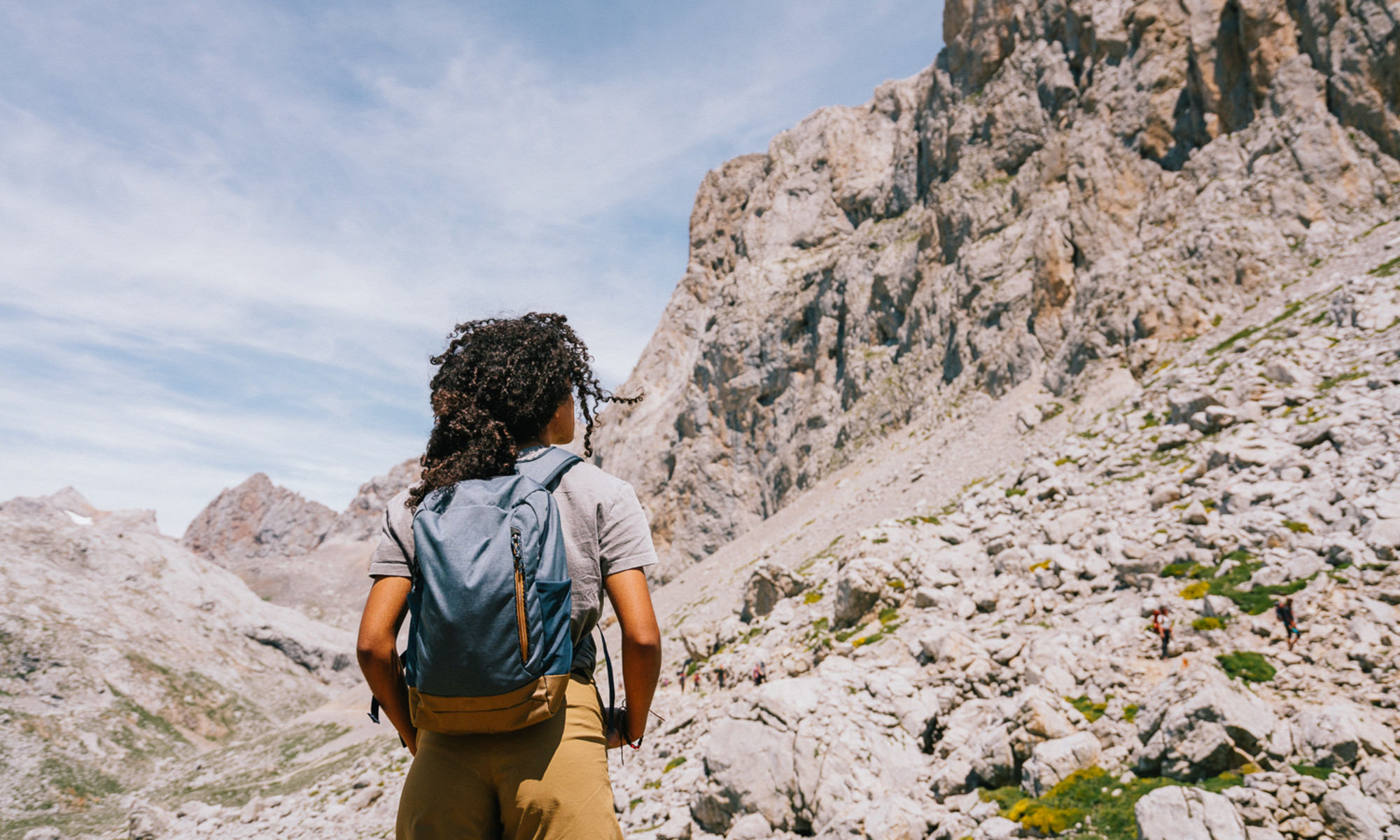The Sacred Symbol of the Horse in Buddhism; Special Significance in Tibet and Mongolia
The horse holds a special place in Buddhism, and profound significance In Tibet and Mongolia. The majestic creature of strength, grace and freedom is deeply rooted in cultural heritage and religious practice. The horse is more than just a...
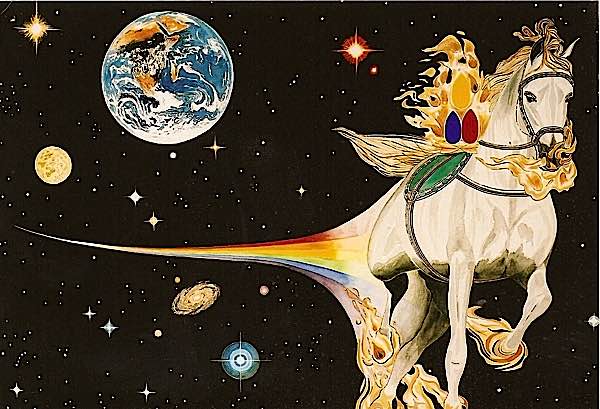
 The Tibetan Windhorse is iconic of Lung or wind (Chi, Prana or breath). The Windhorse symbolically carries the prayers and wishes of practitioners to the Universe.
The Tibetan Windhorse is iconic of Lung or wind (Chi, Prana or breath). The Windhorse symbolically carries the prayers and wishes of practitioners to the Universe.The horse holds a special place in Buddhism, and profound significance In Tibet and Mongolia. The majestic creature of strength, grace and freedom is deeply rooted in cultural heritage and religious practice. The horse is more than just a physical entity — it embodies spiritual virtues and the timeless quest for enlightenment.
By Beth Rush
Of Body+Mind Magazine
 Buddha on his famous beloved horse Kanthaka with his attendant Chandra behind. Shortly after this scene, the brave prince renounces worldly riches and power, cuts his hair, and becomes a poor medicant searching for Enlightenment. Horses, chariorts, bows and arrows are common terms in Sutra, often used as metaphors.
Buddha on his famous beloved horse Kanthaka with his attendant Chandra behind. Shortly after this scene, the brave prince renounces worldly riches and power, cuts his hair, and becomes a poor medicant searching for Enlightenment. Horses, chariorts, bows and arrows are common terms in Sutra, often used as metaphors.
Siddartha Buddha and Kanthaka
The story of Siddharta Gatauma Buddha’s renunciation and his separation from his beloved horse, Kanthaka, is a touching and significant story in Buddhism. As Siddharta — later known as Shakyamuni Buddha — decided to leave behind his life of luxury and embark on a spiritual journey, he faced the task of saying goodbye to his beloved horse. [2]
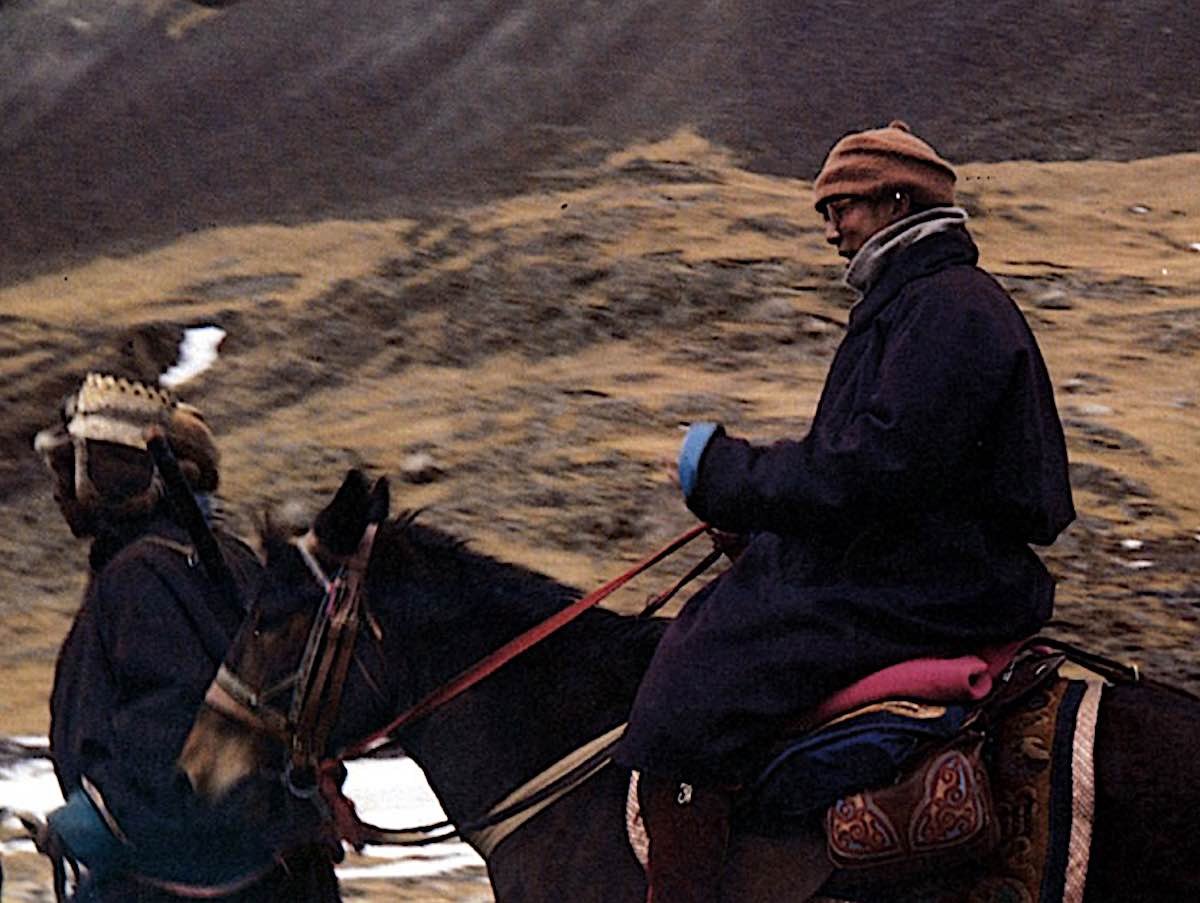 The Dalai Lama on horseback in 1959 overcoming the obstacle of persecution and exile. Horses were vital to the people of Tibet and Mongolia and other areas and are treasured companions.
The Dalai Lama on horseback in 1959 overcoming the obstacle of persecution and exile. Horses were vital to the people of Tibet and Mongolia and other areas and are treasured companions.
Kanthaka, a magnificent horse, had been more than just a mode of transport for Shakyamuni Buddha. He was a loyal and cherished friend, accompanying him through the palace grounds and the city streets.
The separation from Kanthaka symbolizes the profound sacrifice and renunciation he took when he renounced worldly attachments in the pursuit of enlightenment. The image of him bidding farewell to his beloved horse resonates deeply within Buddhist teachings, serving as a reminder of the impermanence of worldly attachments and the sacrifices necessary in the pursuit of awakening and spirituality.
 Gesar of Ling and his legendary horse. They especially stand as enduring symbols of the importance of fearlessness in Buddhism. For a story on Gesar of Ling, see>>
Gesar of Ling and his legendary horse. They especially stand as enduring symbols of the importance of fearlessness in Buddhism. For a story on Gesar of Ling, see>>
Horses are fantastic companions who understand human behavior and feelings, and share a special bond with humans. [3] This is likely why Siddharta felt so attached to Kanthaka, who initially refused to leave him. However, after seeing the poverty on the streets outside his luxurious palace, he knew it was what he needed to do. [2]
The Symbol of the Horse in Buddhism
The symbol of the horse — or more specifically, the wind horse — holds a significant place in the Traditions of Central Asia, symbolizing the winds of lifeforce of our bodies. [1] In Tibetan Buddhism, it occupies a central role within the symbolism of the four cardinal directions, representing well-being and good fortune. It’s also associated with a specific type of prayer flag adorned with images of five animals, including the wind horse. [1]
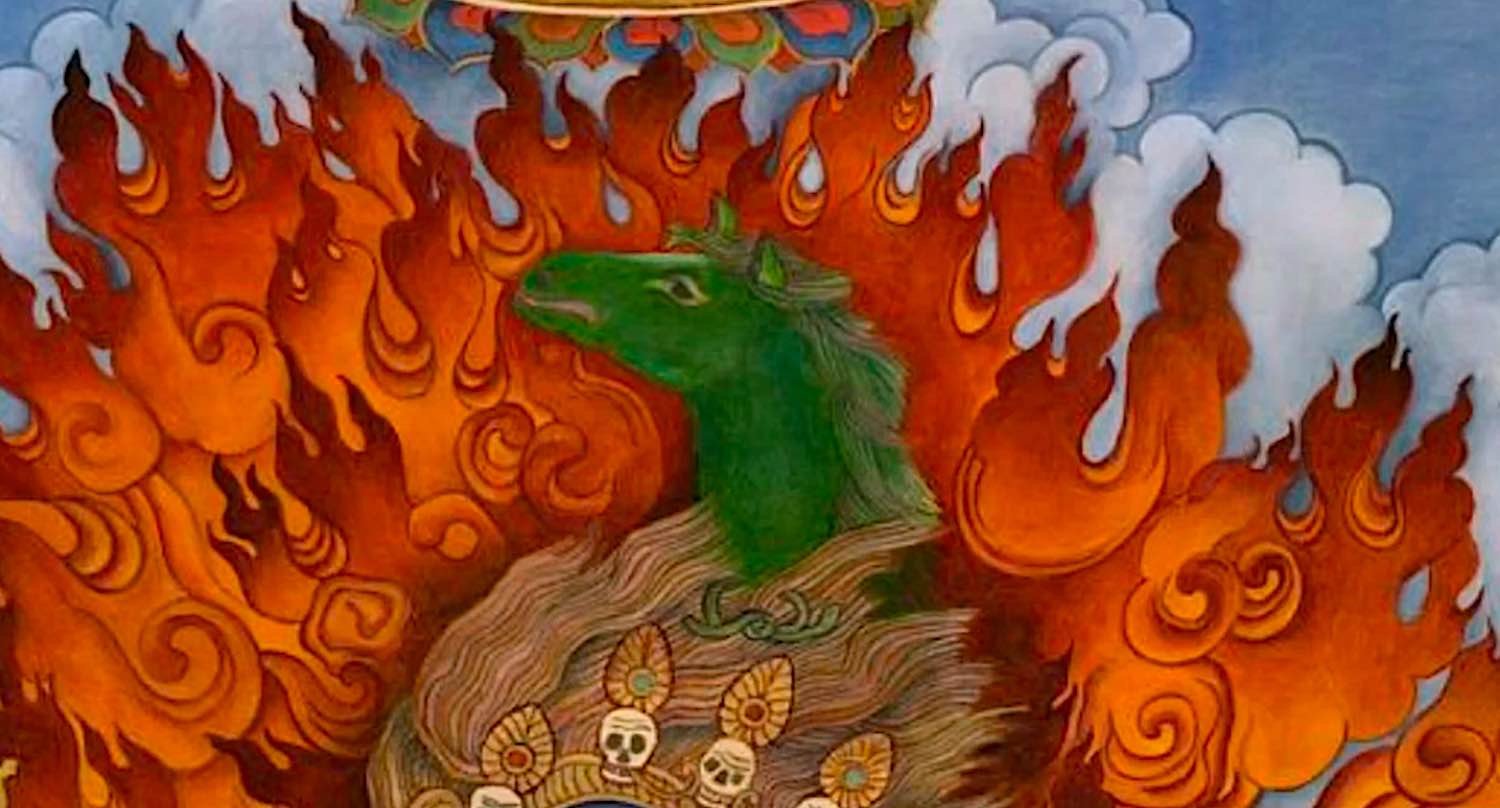 Green Horse head of Hayagriva, symbolic of his wrathful and compassionate healing energy — and Chi or Wind in the body. (Detail from Laura Santi’s painting.)
Green Horse head of Hayagriva, symbolic of his wrathful and compassionate healing energy — and Chi or Wind in the body. (Detail from Laura Santi’s painting.)
Often depicted alongside the four guardian animals of the cardinal directions — Garuda, Dragon, Lion and Tiger — the wind horse forms an integral part of the Lungta composition. While typically depicted without wings, it carries symbols such as the Three Jewels or the wish-fulfilling jewel, symbolizing peace, wealth and harmony. Ritual invocations of the wind horse are often conducted in the morning or during the waxing moon, with the prayer flags themselves being referred to as wind horses. These flags flutter in the wind, carrying prayers to the heavens like a horse racing through the wind.
Many people still use this phrase today to describe their luck. The phrase “my wind horse is running,” or “my wind horse is not running” describes whether or not someone is experiencing good or bad luck.
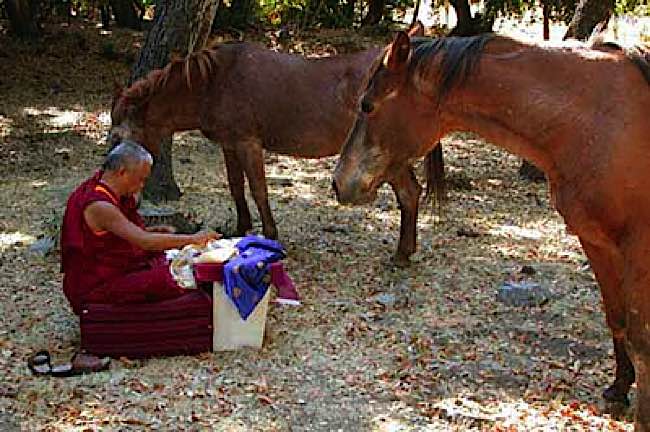 Lama Zopa Rinpoche blesses horses at a rescue farm.
Lama Zopa Rinpoche blesses horses at a rescue farm.
In Buddhist symbolism, the presence of the four guardian animals surrounding the wind horse signifies the triumph over the four great fears — fear of grief (śoka-bhaya), fear of death (maraṇa-bhaya), fear of a bad destination (durgati-bhaya), fear through timidity (parṣadaśādya-bhaya). [2]
The color arrangement — red, blue, yellow and white — with the green wind horse at the center mirrors the layout of a Buddhist mandala, with the green element representing air embodied by the Amoghasiddhi at its heart.
 Prayer flags are ubiquitous in the Himalayas. Printed on them are usually a windhorse, surrounded by the four auspicious ones — Garuda, Dragon, Tiger, Snow Lion (called the Four Dignities) — with prayers and mantras. The wind carries the blessing to world. For a feature on the Sacred Auspicious Ones see>>
Prayer flags are ubiquitous in the Himalayas. Printed on them are usually a windhorse, surrounded by the four auspicious ones — Garuda, Dragon, Tiger, Snow Lion (called the Four Dignities) — with prayers and mantras. The wind carries the blessing to world. For a feature on the Sacred Auspicious Ones see>>
Horses and Meditation Practice
Meditation is a key part of Buddhist culture, used for centuries for its ability to improve self-awareness and relieve stress. In cultures where the horse symbolizes strength, vitality and spiritual connection, meditation camps offer practitioners a sacred space to deepen their understanding of themselves and the world around them. Just as horses are known for the ability to travel vast distances and embody freedom, meditation camps allow you to look inward, exploring your consciousness and forging a connection with the mind.
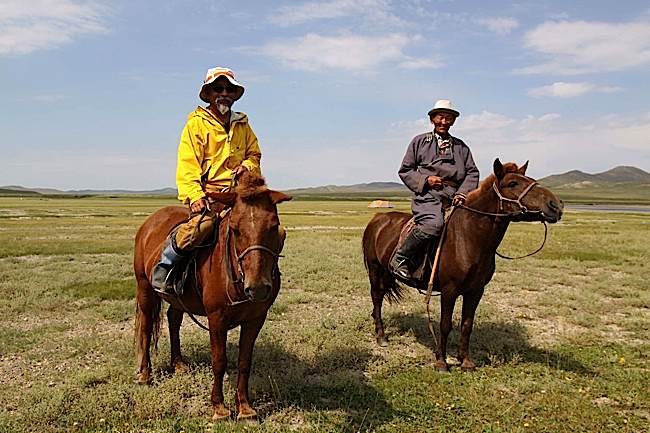 Zasep Tulku Rinpoche (left) on a mission in Mongolia. Many areas in Mongolia are still only accessible by horse.
Zasep Tulku Rinpoche (left) on a mission in Mongolia. Many areas in Mongolia are still only accessible by horse.
Additionally, horses have a calming presence, making people feel relaxed and at ease. [4] Equine-guided meditation is a popular type of meditation, where having horses present offers a sense of safety and security. They’re known to help people feel less self-conscious during meditation practices. [5]
Companionship and Freedom
The symbol of the horse represents vital energy and spiritual progress. As practitioners continue their journeys, the horse serves as a companion, guiding them forward on their quest toward awakening and liberation. Its imagery continues to inspire and guide, reminding them of the interconnectedness of all beings and the boundless potential inherent in each person to realize their true nature.
Sources
https://tibetuniversaltravel.com/tibetan-buddhist-symbolic-animals-and-mythical-creatures/ – Tibet Universal Travel https://www.worldhistory.org/Siddhartha_Gautama/ – World History https://threeforksranch.com/blog/horseback-riding/ – Three Forks Ranch https://margarethamontagu.com/equine-guided-meditation-and-mantras/ – Margareta Montagu https://www.tandfonline.com/doi/full/10.1080/0164212X.2022.2156428 – T&F Online
 AbJimroe
AbJimroe 








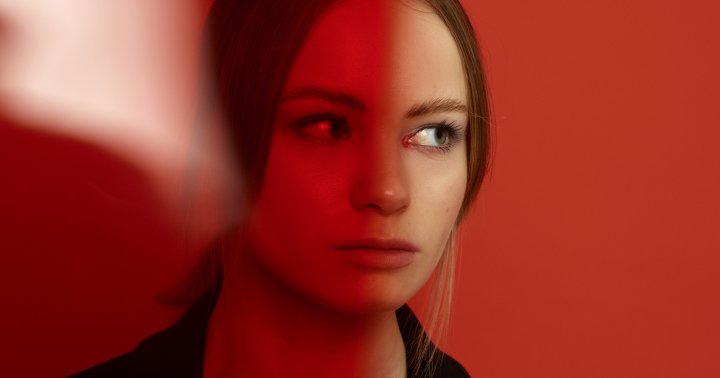

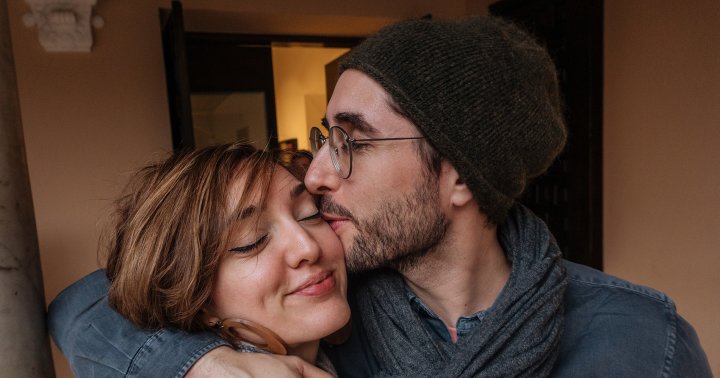














.jpg&h=630&w=1200&q=100&v=6e07dc5773&c=1)




